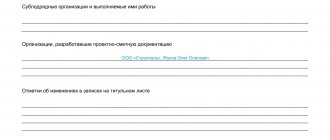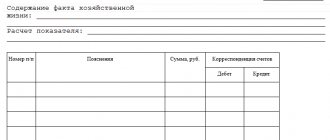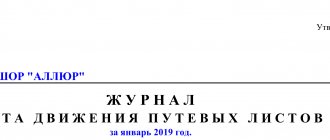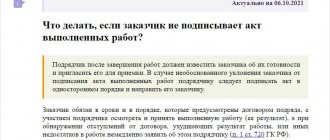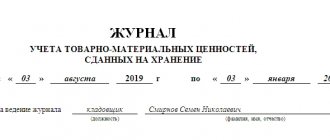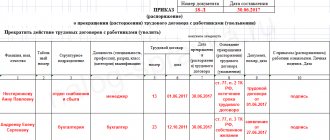KS-6a or Logbook of Work Completed is a specialized formalized journal related to primary documents, mandatory for completion upon completion of any construction and installation work at any construction site. It is conducted objectively. The journal should reflect the stages of work, conditions and deadlines.
The designer of this magazine is the performer represented by his responsible representative. The journal begins to fill out on the same date that work actually began.
Please note: on the basis of the KS-6a journal, a Work Acceptance Certificate is drawn up.
Main purpose
Control of construction and installation work is carried out both by stages, and by individual types, and by the facility as a whole. For example, upon completion, an acceptance certificate is signed in form KS-11. In the case of the KS-6a form, the purpose of the document comes down to 3 tasks:
- Accounting for all work actually completed at this stage (reporting function).
- Accounting for the development of the estimate - subsequently, on the basis of financial data, a certificate of cost is drawn up (its form is designated KS-3).
- Finally, the document can be used as primary or additional evidence during possible trial or pre-trial proceedings (in case of disagreement).
The journal must be kept by the contractor with whom the customer has entered into a corresponding agreement. The data to be filled out is taken on the basis of measurements taken, their correlation with accepted standards and prices that are relevant at a given time. Measurements and assessments are made:
- for a specific type of work (for example, installation of structures, finishing, roofing, excavation, etc.);
- for each structural element (foundations, walls, ceilings, etc.).
The journal is filled out for each calendar year. When a new year begins, a new document must be created.
What is the KS-6 form (general work log)
Form No. KS-6 was approved by Decree of the State Statistics Committee of Russia dated October 30, 1997 No. 71a. It corresponds to number 0336001 according to OKUD. It is used to record the performance of various works related to construction and installation, and is one of the primary documents that record the technological sequence, quality level, conditions for the production of relevant types of work, as well as their timing.
The form in question is used when carrying out work within the same construction site, involving the construction, reconstruction or expansion of objects that can be combined into a group of the same type or considered as independent.
The general work log in the KS-6 form is kept by an authorized employee of the developer, customer or performer of work at the site, for example, a senior work producer or shift manager who is responsible for carrying out production work at the site.
The following can take part in the procedure for filling out the KS-6 form:
- developer representatives;
- customer representatives;
- employees of the organization developing design solutions.
Along with the KS-6 form, the Russian construction industry uses a document approved in Appendix No. 1 to Rostechnadzor Order No. 7 dated January 12, 2007 (this regulatory legal act was also assigned another number - RD-11-05-2007).
Many legal entities and individual entrepreneurs working in the construction industry fill out both forms for reporting purposes, since in practice government agencies carrying out construction supervision can request either of them - there are no clear criteria for choosing a specific form of the general work log in the legislation.
Read about the features of cost accounting during construction work in the material “Procedure for accounting costs in construction (nuances).”
Construction control is a mandatory stage, the absence of which can lead to fines. ConsultantPlus experts explained in detail how to properly carry out construction control and reflect it in the general work log. Full trial access to the K+ system can be obtained for free.
How to fill it out correctly
Filling is cumulative in nature - as the next stage of construction work is completed (or the final installation of a separate structural element), a new cost is filled in. The number of pages will vary, but all information in it is filled out in tabular form.
Front page
The document should reflect the following information:
- Information about all aspects of the work (about the customer and the contractor):
- names (can be abbreviated, for example, Stroybeton LLC);
- legal addresses;
- Contact phone numbers.
- The name of the construction site and its address, for example, “A 10-story residential building with an underground parking lot for 100 cars and a heating point.”
- Object - this means a specific type of construction and installation work (for example, carrying out general construction earthworks for the “name of the construction site”).
- Codes for OKUD, OKPO and OKDP.
- Information on a previously signed contract: date of signing and number.
- The name of the document, an indication of the year for which it is maintained.
- Cost of construction work under the contract (in words, in rubles, without kopecks).
- A note about who filled out the form (for example, a capital construction engineer): signature, position, signature transcript.
- A note about who checked the filling (usually the general director) - similar to the position, signature and transcript of the signature (last name, initials).
Main part: even pages
The main part of the form is presented in the form of a table. Moreover, on the even-numbered pages there is a table indicating all the work performed by month. The following data is provided:
- Numbering is carried out in order (chronologically), as well as in accordance with the numbering according to the estimate - i.e. 2 systems are used at once.
- This is followed by the name of the type of construction and installation work (in accordance with the accepted classification) or the name of the structural element on the creation of which the work has been completed.
- The price number, unit of measurement, and price for this unit (in rubles) are given.
- The amount of work is prescribed in accordance with the estimate (the amount is indicated).
- The estimated cost is written down.
- This is followed by a report for each month (for work actually completed). The following information is provided:
- quantity and cost;
- cost on an accrual basis (cumulative order) – i.e. since the beginning of the year in total.
Body: odd pages
For odd-numbered pages, information continues to be recorded only by month:
- quantity and cost;
- cumulative total cost.
Filling out sections of the KS-6 form
A sample of filling out the KS-6 form can be downloaded from our website:
Section 1 states:
- Full name, positions of the company employees performing the work, as well as the areas in which they work (for example, “Andreev S.V., foreman, installation of building structures”);
- start and end dates of work performed by a specific employee;
- information about the document confirming the employee’s qualifications (for example, “Engineer Qualification Certificate No. 111 222, issued on 12/10/20XX”).
To learn about the professional requirements for construction workers, read the article “Professional Standards in Construction.”
Section 2 reflects:
- names of various acts related to construction (for example, “Act on the assembly of building structures”, “Act on approval of the technical report and drawings”);
- dates of signing of the relevant acts, full names and positions of the employees who signed them.
For each act, a serial number is recorded.
Section 3 states:
- dates of activities for monitoring and assessing the quality of work;
- names of structural parts of buildings, indication of their location, links to the numbers of the corresponding drawings (for example, “Pit, drawing No. 20 dated 08/20/20XX”);
- control results (for example, “The pit corresponds to the drawing, there are no complaints”);
- names of the companies that carried out the inspection, full names and positions of the inspection specialists.
In section 4 it is necessary to record:
- names and dates of issue of special journals used during the implementation of the construction project (for example, “Journal for conducting engineering tests, 04/15/2017”);
- names of companies maintaining relevant journals, full names and positions of employees responsible for maintaining these documents;
- dates of delivery and acceptance of special journals, signatures of the general director of the contractor organization.
Section 5 provides:
- start and completion dates of work - in one column (for example, “05/01/2017–05/17/20ХХ”);
- description of the work, conditions for its implementation, full name and position of the responsible persons (for example, “Installation of construction equipment, responsible: foreman Andreev S.V.”);
- position and signatures of the employee responsible for working with the magazine.
For information on the document used to formalize the acceptance of completed construction work, read the material “Acceptance Certificate of Completed Construction Work - Sample.”
Section 6 is completed by employees of government agencies. They record:
- date of inspection;
- comments, full names, positions of inspectors;
- notes indicating that the comments were accepted for implementation, and checking that the reasons that caused them have been eliminated.
On the last page of form No. KS-6 after section 6 the following is indicated:
- number of sheets in the document;
- Full name, position, signature of the person in charge, seal;
- date of signing of the journal.
Sample and form 2022
This year, there have been no changes in terms of the form of the journal and the requirements for filling it out. A ready-made example of a completed KS-6a form, which you can rely on as a sample, is given below.
Here's a blank form:
All empty fields are neatly crossed out with a simple straight line of the same color that was used to fill out the main part of the magazine.
NOTE. Corrections, blots, unreadable inscriptions, strikethroughs and the inscription “Believe what is corrected” are not allowed in the journal. The form must be filled out with the utmost care; if necessary, individual sheets with erroneous information are replaced with new ones with correct data.
Is it necessary to keep a journal?
Among engineers, the question of how obligatory it is to keep a journal is often discussed, and whether it is possible to get by with a different model, adapting the form to suit your specific tasks. The answer in this case is unequivocal: maintaining the document is mandatory, since it is the main source of information for recording all construction work performed - both by type and by individual structural elements.
In addition, it is on the basis of this data that the associated reporting documents - KS-2 and KS-3 - are formed. Therefore, correct, timely and complete registration of the journal is mandatory for each responsible person (usually one of the engineers is appointed).
NOTE. The absence of form KS-6a may be considered by tax inspectors as a violation of the law. In this case, there is no reason to believe that KS-2 and KS-3 were drawn up correctly, since there is no source of information on the basis of which these documents were drawn up.
Are journals KS-6, KS-6a and RD-11-05-2007 required to record work performed?
Information from the Ministry of Finance of the Russian Federation dated December 4, 2012 No. PZ-10/2012 contains the department’s opinion with reference to the new law dated December 6, 2011 No. 402-FZ that it is not necessary to use unified forms of primary documentation from 2013.
These forms, on the one hand, include forms KS-6 and KS-6a. On the other hand, there are no criteria that allow us to classify the RD-11-05-2007 form as unified. What document, then, should Russian builders use to record work?
In this case, it is legitimate to talk about the need for a correct comparison of legal norms and law enforcement practice.
As for the first aspect, the provisions of sub. “b” clause 13 of the Decree of the Government of the Russian Federation dated 01.02.2006 No. 54 instructs construction supervision authorities to somehow check the availability of a general work log. On the one hand, the legislator does not specify its form, on the other hand, in the same subsection. “b” clause 13 of Resolution No. 54 introduces a rule according to which the procedure for maintaining the relevant journal is established by Rostechnadzor. Since this department issued document RD-11-05-2007, we can conclude that the form of the construction work log should, first of all, correspond to that approved in RD-11-05-2007.
However, as practice shows, in many regions of the Russian Federation, construction supervision authorities, due to the established legal tradition, require keeping a log in the KS-6 form. Sometimes both forms are requested at once.
Moreover, among lawyers there is a widespread point of view according to which form No. KS-6a is primary in relation to other journals, even in cases where the real estate object is the only one on the site. Since it is not necessary to use unified forms, the construction supervision authority may well request it (or a similar one).
Thus, in practice, it may be necessary to provide the construction supervision authority with all 3 documents we considered:
- form KS-6;
- form KS-6a;
- form RD-11-05-2007.
It all depends on the policies of regional government structures that supervise the construction sector. But very often the state limits itself to requesting a document approved in accordance with RD-11-05-2007 - perhaps due to the fact that the need to fill it out becomes obvious upon a literal reading of the provisions of Government Resolution No. 54 dated 01.02.2006.
For information on how labor protection is carried out during construction work, read the material “Rules for labor protection in construction.”
